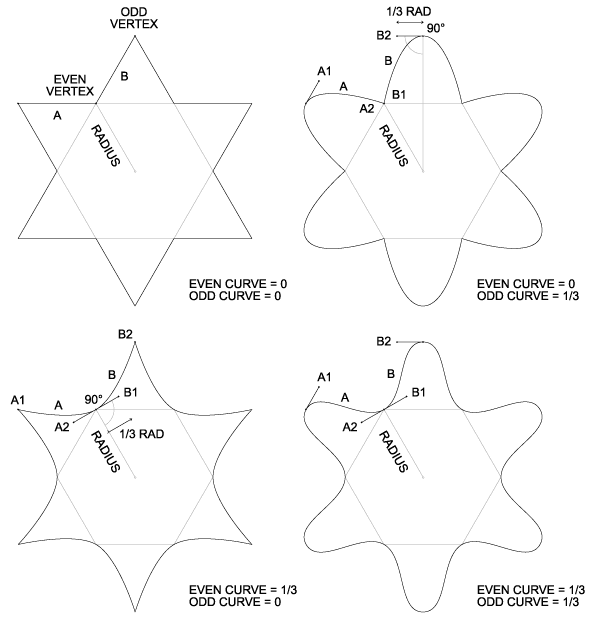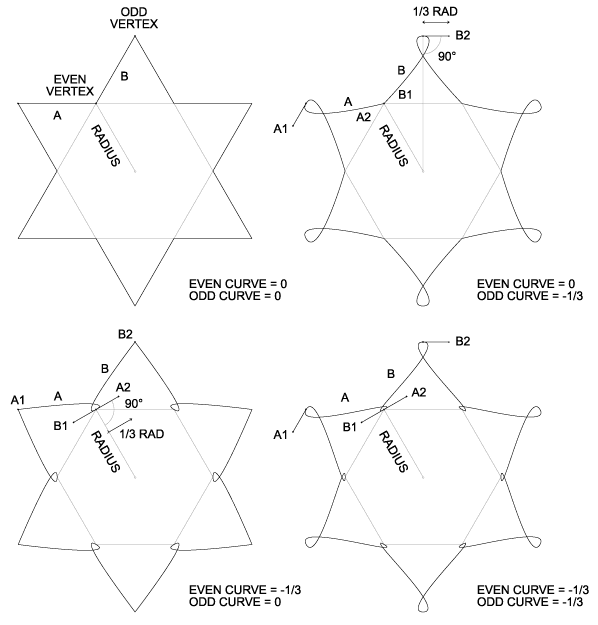

A more complete illustration suitable for printing is here. Illustrations and text kopyleft 2006 Chris Korda, all rites reversed.
Background: A star is a regular polygon, but with an extra vertex between each normal vertex. The normal vertices are "even", while the extra vertices are "odd". By convention, the star's radius is the radius of any even vertex. The ratio of the odd radius to the even radius determines whether the star is convex (the points bulge outward) or concave (the points collapse inward), i.e. if odd_radius / even_radius > 1, the star is convex. For details, see: Star Factor.
Given a star as defined above, we would like to substitute curves for the usual line segments between each vertex. The end points of the curves are assumed to be the same as the end points of the line segments. The number of curves will be the same as the number of line segments, or N * 2, where N is the number of sides in the polygon from which the star is derived. The only remaining problem is, how to generate the two control points for each curve?
The solution must satisfy the following constraints:
What unit should the curvature unit be in? By making it a fraction of the radius, constraint #4 can be satisfied trivially. For example, a curvature of 1 equals the radius, a curvature of .5 equals half the radius, etc.
The solution can be described as follows: For each vertex, draw a line tangent to the center of the star through the vertex. The two nearest control points (one for each neighboring curve) will lie along this line, and will be equidistant from the vertex. The distance from the vertex is given by the star's radius times the appropriate curvature (even or odd). Note that the curvature may be negative, in which the control points are reversed, causing the curves to loop in the opposite direction.
Assuming the star's vertices are already calculated, the above solution can be implementated relative easily. At each even vertex, two curves A and B intersect; the corresponding pair of curve control points A2 and B1 can be calculated as follows:
Since both rotations are 90 degrees, they can be accomplished via coordinate swapping instead of costly trig functions. Thus the solution can be reduced to one subtraction, four additions, and two multiplies, for each vertex. Note that constraint #3 (symmetrical curvature on both sides of each vertex) can be partially relaxed by scaling the A2 vector differently from the B1 vector, however if the constraint is abandoned entirely, the vectors are no longer necessarily tangent, and trig is unavoidable.
int CWhorldView::MakeCurves(const RING& rp, const DPOINT& Origin)
{
int sides = rp.Sides << 1; // number of vertices
int points = sides * 3 + 2; // one extra for duplicate control point
CPoint org(round(Origin.x), round(Origin.y));
POINT *pp = m_bpa; // pointer to array of bezier points
CPoint pt, delta;
float curvature[2] = {rp.EvenCurve, float(rp.OddCurve / rp.StarRatio)};
for (int i = 0; i < sides; i++) {
pt = m_pa[i]; // next vertex
delta = pt - org; // construct vector from vertex to origin
float r = curvature[i & 1]; // odd or even curvature
delta.x = round(delta.x * r); // scale the vector
delta.y = round(delta.y * r);
*pp++ = CPoint(pt.x - delta.y, pt.y + delta.x); // previous curve's 2nd control point
*pp++ = pt; // this curve's start point
*pp++ = CPoint(pt.x + delta.y, pt.y - delta.x); // this curve's 1st control point
}
*pp++ = m_bpa[0]; // copy final control point
*pp++ = m_bpa[1]; // close the shape
return(points - 1); // skip first point: shape begins at m_bpa[1]
}